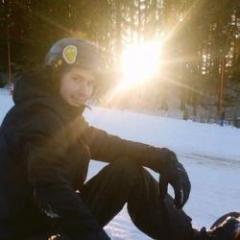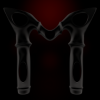Search the Community
Showing results for tags 'map'.
-
Hi all! Is there a way to masking (a smart material, for example) by using a map? I´m able to use a map as a stencil, and I also can import maps as curvature, AO, etc However, I´m not able to find the way to use the map based on the UVs (I also try the Preferred Mapping set as UV mapping, however, the result is this: The UVs are correct (I´ve tried them in other softwares). I´m a beginner in 3DCoat, so I´m sorry if this is a really basic question (however I did not find anything in the forums or internet or tutorials. The same way to import the ID map (In other topic on this forum I saw this tutorial: It´s useful and I´ve been able to import the ID layers. However, when I apply a Smart material on one of the ID layers I brought, it is applied on the entire object. What I´m doing wrong? Thank you very much!
-
Hi ! I painted my model without using retopology and UV mapping. It is possible to export the texture in this way ?
-
у меня есть модель специально разделённая на разные ретопо группы. Это сделано для того чтобы можно было скрывать часть лоу-поли модели и часть floating geometry на хай-поли - в местах где она пересекается с другой плавающей геометрией для других частей модели. Проблема в следующем: когда я запекаю нормал для одной части модели, потом скрываю её и включаю следующую часть модели и запекаю новые детали - то ещё один нормал мап уже не рендерится. Просчёт идёт - но нормал мап так и не появляется. Если же удалит старый нормал мап - то новый просчитывается без проблем, но следующий не просчитывается опять. Как отрендерить несколько нормал мап с разных участков геометрии?
-
What are the proper export settings for normal maps from 3D Coat to Maya (Arnold IOR)? In File > Preferences I have tried using numerous normal settings (Software Preset, Calculation Method, Swap TB), but I still feel like my normals are looking inverted in the Maya Arnold render. What is the proper normal map export workflow?
-
Hey, I'm a new user with minimal lightwave/modo background. I'm basically just a hobbyist. I just started trying out 3D-Coat a few days ago. Most things feel really nice to me. I feel at home already. I have a quick question though: In the PAINT room I have tried calculating AO and curvature maps for models. Both worked fine. But while I was able to properly put the AO layer on top of a material in the layer stack, I could not do the same with the curvature map. I have set the blending to multiply (or similar), but it doesn't seem to have any effect? What am I doing wrong?
-
Hey I'm currently tying out the "Calculate Occlusion" tool on a few of my models but have run into a problem on one of them. The occlusion map produced has a lot of ugly sort of patches all over it. I ran the tool on a very similar model and never had any issues. I have all layers, paint objects and surface materials unlocked. I have attached images of the before and after of the model with errors and the similar model without. Any help on how to solve this issue would be much appreciated. Thanks.
-
Hi all, I would like to ask you about using real-scale textures for paint. If i got e.g arroway texture i know real scale coverage (eg.1mx1m) So i would like to "fix" brush size. Is it possible? Thanks, Michal
-
As part of my ongoing saga to paint a rock: In the attached you can see the render from 3Dcoat on the left and the corresponding obj in Cinema 4D on the right. Some layers are missing. The reason I know this, apart from the difference in appearance is the fact that the moss only appeared when I exported the colour map separately and overwrote the old one. I did the same for the normals and they improved too. The Psionics, Alien-something, official and everything else tutorials on the subject show a straight export of the obj (File>Export) - and everything works fine. Even now that the moss is appearing, it still looks wrong - it should be bulbous for a start and there's obvious detail and colour/texture layers missing from the rock.
-
Hello to everyone. Thank you for your help... The following video tutorial by Phil Nolan is excellent for photo to 3d model> (https://www.youtube.com/watch?v=D6eqW6yk50k&t=30s). I created a 3D model with Phil's shared rock photos (https://www.dropbox.com/s/g9rxzs59lt59pq3/rock_video_images.zip?dl=0). I want to clear the mesh surplus with 3DCoat software; 1) File> New> Voxel Sculpting> Open> Rock.obj (https://www.dropbox.com/s/uf8jq27dyl5bh3b/Rock 3DCoat Import.rar?dl=0) 2) I clean it with the help of "cut off" tool (https://www.dropbox.com/s/m02dzml45j6s62p/Rock 3DCoat Cleared.rar?dl=0) 3) I'm going to the "paint" tab. 4) "Export Objects & Textures" (It does not create the "texture" file!) 5) Textures> Export> Color / Albedo Map (Black "texture" file!) I want to create OBJ and Texture map files. I'm cleaning up, doing OBJ, creating texture map. But it is black! Can you help me with this? Do you know a training video to help me? I'm doing the wrong thing. l want to 3D scanned (Photo to 3D mesh) model and texture map (original scanned point texture map) from 3DCoat software (It's not an FBX file!). Subject; 1) Rock Cleared.obj (Close or open mesh!) (https://www.dropbox.com/s/8syibbsevab9h4h/Rock Cleared.rar?dl=0) 2) Rock Cleared.jpg (Color map!) (https://www.dropbox.com/s/8syibbsevab9h4h/Rock Cleared.rar?dl=0) I want to scan different models. I am waiting for help and an answer. Thank you...
-
I've made a few test meshes in Blender and all of them have the same problem - missing edges (seems random) in curvature map and jagged curvature edges: I've attached the mesh that I've used here, what's wrong with it? I've tried changing UV maps and nothing changed... I've also made a few different simple meshes like this one, and these missing curvature edges seem to appear random. testMesh.rar
-
I haven't had a chance to test the latest beta to see if this is in there or not, but it would be great to be able to have a "Set to Default(s)" for the environment map. I changed it in the last beta and then couldn't figure out how to get back to default. Also, having this setting stay the same every time I open the program can be nice and a pain in the neck. Would be great to offer an option to save with each project AND to have a custom default setting.
-
- reset
- environment
-
(and 3 more)
Tagged with:
-
When working on models for video games which require low resolution textures and normal maps (512x512 maximum), I sometimes run into the problem that normal maps come out pixelated while other times they do not. It's weird because sometimes they are smooth, others they are pixelated... and others they are both... Do you guys know some tips for avoiding pixelation (or what causes it) when baking normal maps at low resolutions? I've tried to find help on this but the recurring solution is increase the resolution... not really an option for me. Here is a recent example of some being pixelated and some being smooth: I tried many different ways of marking the seams, scaling the islands, separating different parts but nothing works. This is an example of a model that refuses to not be pixelated. Original model: Mesh: Mesh with Normal Map and Simple Textures (512x512): And normal map (the island on the top left is the inside which will not be seen so it is not properly mapped, I tried shrinking that and increasing everything else as well but that didn't work either):
-
Does anyone else have problems importing fbx files into UE4? I import the fbx, color, and normal maps and almost everything has at least one black spot on it after rebuilding lighting. Other than the black spot, everything looks awesome.
-
Hi, i used the auto seams feature and unwrapped... the uvs turned out to be incredibly disproportionate. The only reason I can see for this is that I have made an incredibly large tri/polygon... but the twist is i cant find this polygon. If there were an invert selection function for the retopo room i could test if this idea is correct but i cant see this function, whut should i do?
-
Does anyone know if there is a way to adjust how More in cavity and less in cavity work when painting a normal mapped model, If not this would certainly be an improvement for 3d coat, its very handy for making things look worn and eroded but depending on your model you may want to adjust the allowance between what is classed as a cavity thanks.
- 3 replies
-
- More in cavity
- less in cavity
-
(and 8 more)
Tagged with:
-
I am totally knew to 3d coat but it seemed just what i needed for character texturing at the time. before i start learning more than the basics i want to know if i can export my model(textured in 3dcoat) with a separate material and diffuse/normal map for the feet, torso, head, skin... if so how? thanks oh and i dont want to have to seraprate my character into objects
-
OK, I've created a multi-subobject Voxel asset, retopologized each, painted each, and now I want all the textures and subobjects combined. I can do this in Max, Photoshop, etc. but I'm trying to determine if there is a way to get this done in 3DC, thereby skipping a bunch of steps. I can see that the UV islands are placed appropriately already, but I don't know how to combine the texture maps together and to also get the assets out as one combined object. Is there a way to do this in 3DC?




